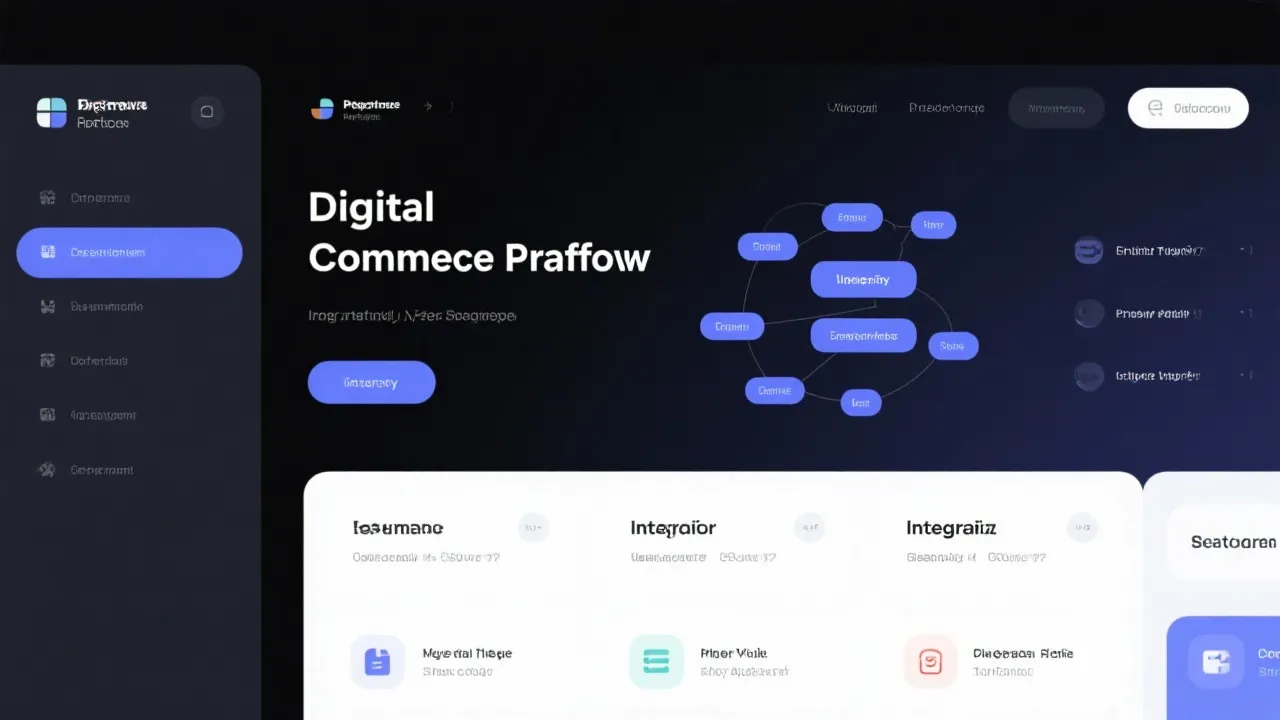Vtex and Salesforce: A Comparative Insight
This article explores the intricate details of Vtex and Salesforce, two leading platforms in digital commerce and customer relationship management (CRM), respectively. It delves into their functionalities, significance in the market, and potential for integration, providing a comprehensive overview crucial for businesses aiming to optimize their operations and customer interactions.

Exploring the Synergy of Vtex and Salesforce in Digital Commerce
In the dynamic world of digital commerce, platforms such as Vtex and Salesforce have carved a niche for themselves. Vtex is renowned for its cloud-based e-commerce capabilities, facilitating omnichannel solutions that cater to businesses of varying scales. On the other hand, Salesforce dominates the customer relationship management (CRM) landscape with its robust tools for sales, service, and marketing automation. The integration of these two powerful platforms can create a synergy that enhances operational efficiency and improves customer satisfaction, thus solidifying a business's market position.
Understanding Vtex
Vtex offers a comprehensive suite designed to streamline e-commerce operations. Its platform is highly adaptable, allowing businesses to create online stores that are both functional and aesthetically pleasing. Vtex supports multiple sales channels, ensuring seamless transactions and customer interactions. This flexibility is crucial for enterprises pursuing digital transformation by embracing versatile solutions that can be tailored to specific needs.
One of the standout features of Vtex is its support for headless commerce. This architecture allows businesses to decouple their front-end presentation layer from the back-end functionality, leading to greater flexibility in how they present their products and interact with customers. Over the years, many retailers have transitioned to this model, allowing them to offer more personalized shopping experiences while optimizing their backend processes.
Additionally, Vtex's native marketplace functionality enables businesses to expand their reach by allowing third-party sellers to list products on their platform. This not only creates a broader product catalog but also answers the growing consumer demand for diverse product offerings from a single source.
An Overview of Salesforce
Salesforce stands as a pillar in the CRM industry, providing businesses with unparalleled tools to manage customer relationships. Its solutions cover various aspects of customer interactions, from tracking sales to automating marketing campaigns. Salesforce's ability to integrate with other systems means it can work in conjunction with platforms like Vtex to provide a holistic approach to customer management and e-commerce.
One of the defining features of Salesforce is its powerful analytics capabilities. Utilizing artificial intelligence through its proprietary Einstein Analytics, Salesforce provides actionable insights that help businesses make informed decisions based on real-time data. This can be particularly advantageous when integrated with e-commerce platforms like Vtex, where immediate access to customer behavior can refine marketing strategies and product offerings.
Moreover, Salesforce excels in its community management capabilities, enabling businesses to cultivate engagement not just with customers but also with partners and employees. This community-centric approach contributes to building a loyal customer base and enhances brand reputation through open lines of communication.
Integration: The Powerful Combination of Vtex and Salesforce
The combination of Vtex and Salesforce presents businesses with a compelling proposition. Integrating these platforms can lead to significant improvements in efficiency, customer satisfaction, and ultimately, profitability. This synergy allows for a streamlined flow of information, enabling businesses to provide personalized experiences across channels.
Consider a scenario where a customer interacts with a business through various touchpoints. By leveraging the data analytics and CRM capabilities of Salesforce alongside the e-commerce strengths of Vtex, businesses can curate these interactions to be more personalized and efficient. This seamless experience ensures that customer expectations are met, which is pivotal in enhancing brand loyalty. For instance, if a customer adds products to their cart on a Vtex-powered store but doesn't complete the purchase, Salesforce can trigger a follow-up email to remind them of the items they left behind, effectively nurturing the lead and increasing the chance of conversion.
The benefits of such integration do not end at customer engagement; they also extend to backend operations. Inventory management, order fulfillment processes, and customer service can all be optimized by integrating Vtex and Salesforce. By synchronizing data across both platforms, businesses can ensure that they operate with the most current information, leading to fewer errors and a more efficient usage of resources.
Financial Impact and ROI
Investing in the integration of Vtex and Salesforce can lead to a positive return on investment (ROI) for organizations. By automating repetitive tasks such as customer follow-ups, data entry, and reporting, businesses can allocate human resources toward more strategic initiatives that drive growth. Moreover, by enhancing customer experience through personalized interactions, businesses are more likely to see increased sales as satisfied customers tend to return and make repeat purchases.
In a digital commerce landscape characterized by rapid change, the ability to adapt is essential. The integration of Vtex and Salesforce enables real-time responses to market changes, consumer preferences, and industry trends. With tailored analytics and reporting generated from the combined data of both platforms, businesses can pivot quickly in their strategies and operations, ensuring they remain competitive.
Table: Comparative Features of Vtex and Salesforce
| Features | Vtex | Salesforce |
|---|---|---|
| Primary Functionality | E-commerce Platform | Customer Relationship Management |
| Supported Integrations | Multiple Channels, APIs | Extensive, APIs |
| User Target | Small to Large Enterprises | Small to Large Enterprises |
| Analytics Capability | Basic Reporting | Advanced AI Analytics |
| Customization | Highly Flexible | Extensive Customization Available |
| Community Features | No | Yes |
The Business Implications of Betting on Vtex and Salesforce
For businesses today, harnessing the power of Vtex and Salesforce means aligning IT investments with digital transformation goals. Vtex allows for extensive customization tailored to demanding retail environments, while Salesforce offers CRM solutions that drive customer-centric growth.
When considering the integration of these two platforms, businesses can improve their market positioning through enhanced data utilization and reduced operational silos. This is particularly important in an age where data-driven decision-making is key to staying competitive. As more enterprises adopt digital solutions, the need for robust and integrable systems becomes increasingly evident.
The overall architecture of this integration allows for the aggregation of customer data across multiple channels. With this consolidated view of customer interactions, businesses can craft more refined marketing strategies, optimize sales funnels, and deliver enhanced customer support. The insights gleaned from cross-referencing e-commerce data with CRM metrics allows businesses to tailor their product offerings, promotions, and communication strategies based on actual customer behavior.
Guidelines for Successful Integration
Integrating Vtex and Salesforce is not without its challenges, and achieving a truly synergistic relationship between the two platforms requires careful planning and execution. Here are some guidelines to ensure a successful integration:
- Define Clear Objectives: Before initiating the integration process, businesses must define what they aim to achieve. Whether it’s improving customer service, increasing sales conversions, or enhancing operational efficiency, clear objectives will guide the implementation strategy.
- Engage Cross-Functional Teams: Involving teams from IT, marketing, sales, and customer service ensures that the integrated solution meets the diverse needs of the organization. A collaborative approach enables more comprehensive adoption and usage.
- Data Governance: Establishing data governance policies is essential for maintaining data integrity and security across both platforms. Businesses should consider how data will be collected, stored, and used to protect customer privacy while complying with legal regulations.
- Testing and Iteration: Prior to full deployment, testing the integration in a controlled environment can help identify possible issues and refine processes. Iterative adjustments based on feedback are essential for optimizing performance.
- Training and Support: Ensuring that staff are adequately trained to use the new integrated system will facilitate a smoother transition. Ongoing support can help address any challenges as they arise.
FAQs
- How does Vtex enhance e-commerce operations? Vtex enhances e-commerce by providing a flexible, multichannel strategy, allowing businesses to reach customers wherever they are and through any device they prefer.
- What are the benefits of integrating Salesforce with Vtex? Integrating Salesforce with Vtex allows businesses to unify their CRM and e-commerce strategies, leading to streamlined operations, better data insights, and personalized customer experiences.
- Can Vtex and Salesforce be tailored for any size of business? Yes, both platforms are scalable and suit the needs of both smaller businesses and large enterprises, allowing for growth and adaptation as the business evolves.
- What types of businesses are best suited for the Vtex and Salesforce integration? Businesses that operate in dynamic sales environments, such as retail and e-commerce firms, benefit greatly from this integration due to the need for rapid response to consumer demands and seamless cross-channel interactions.
- How can businesses measure the success of the integration? Success can be measured through key performance indicators (KPIs) such as customer engagement rates, conversion rates, average order value, and overall sales growth. Regular assessments can help in making data-driven optimizations post-integration.
In conclusion, the potential of combining Vtex and Salesforce lies in their ability to provide an all-encompassing digital solution for businesses. By aligning their operations across commerce and customer relations, companies can ensure they remain competitive in an increasingly digital-first marketplace. The integration not only streamlines processes but also helps in crafting personalized experiences that resonate with customers, ultimately leading to sustainable growth and profitability. As the future of commerce evolves, leveraging the strengths of both Vtex and Salesforce will position businesses favorably amid the challenges of a rapidly changing landscape.
-

A Guide to Cost-Efficient Small Electric Cars for Seniors
-

Mastering Debt Consolidation: Boost Your Credit Score and Manage Interest Rates
-

Your Guide to Loans, Credit Checks, and Interest Rates
-

Affordable Independent Living: Finding the Right Senior Housing
-

Guide to Senior Living Apartments: Affordable and Comfortable Environments










